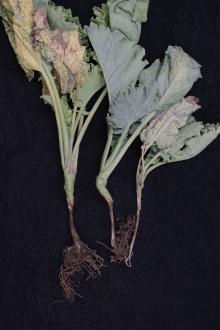Cause The fungi or fungus-like microorganisms, Pythium spp., Fusarium spp. and Rhizoctonia solani, attack young seedlings of many vegetables, including members of the genus Brassica. These soilborne microorganisms can persist indefinitely in soil or plant debris. If seedlings are affected before emergence, it appears as poor germination. If the decay is after emergence, seedlings that fall over or die are said to "damp-off." The destructiveness of the disease depends on the amount of pathogen in the soil and on environmental conditions. Cool, cloudy weather, high humidity, wet soils, compacted soil, and overcrowding especially favor development of damping-off.
Symptoms Damping-off kills seedlings before or soon after they emerge. Beneath the soil a general rot is observed. Seedlings that emerge develop a lesion near where the tender stem contacts the soil surface, and the seedling collapses. In some cases, the seedling may continue to grow even though the lesion girdles the stem. The lesion is quite sunken, and the stem resembles a wire, hence the name wirestem. The girdled seedling eventually dies.
Cultural control
- In the greenhouse or seedbed, pasteurize the soil with heat. Use good sanitation in greenhouses.
- Locate seedbeds on well-drained soil, and avoid excessive irrigation.
- Space rows and/or seedlings in the seedbed to maximize air movement.
- Carefully examine seedlings when transplanting; discard any with signs of wirestem.
- If damping-off occurs, stop watering for a while. Allow soil to dry somewhat around the plants. If the seedlings are in flats or in cold frames, give them as much air and light as possible.
- Crop rotation with cereals may reduce pathogen populations in the soil.
- Remove or encourage decomposition of plant debris.
Chemical control
- Seed treatment.
- Allegiance-FL (Group 4) at 0.75 fl oz/100 lb seed plus a dye can be used where Pythium spp. are a problem. See label for reentry restrictions.
- Apron XL (Group 4) at 0.085 to 0.64 fl oz/100 lb seed plus a dye, can be used where Pythium spp. are a problem. See label for reentry restrictions.
- Dynasty (Group 11) at 0.10 to 0.38 fl oz/100 lb seed plus a dye. Use in combination with other active ingredients labeled for seed treatment. See label for reentry restrictions.
- Maxim 4FS (Group 12) at 0.08 to 0.16 fl oz/100 lb seed for control of pathogenic Fusarium and Rhizoctonia spp. See label for reentry restrictions.
- 42-S Thiram (Group M3) at 8 fl oz/100 lb seed plus a dye. See label for reentry restrictions.
- Soil treatment.
- Quadris Flowable (Group 11) at 0.4 to 0.8 fl oz/1,000 row feet applied in a 7-inch or less band either in-furrow at planting or as a directed spray at cultivation. 4-hr reentry.
- Uniform (Group 11) at 0.34 fl oz/1,000 row feet applied in a 7-inch band in-furrow at planting. 0-hr reentry.
Biological control Efficacy in the Pacific Northwest is unknown.
- Actinovate AG at 3 to 12 oz/A as a soil drench at planting. 4-hr reentry. O
- Actinovate Lawn & Garden at 1/2 to 1 teaspoon/gal water. H O
- Bexfond at 7 to 14 fl oz/A. 4-hr reentry. O
- Bio-Tam 2.0 at 2.5 to 5 lb/A as a broadcast at sowing. See label for different methods and rates of application. 4-hr reentry. O
- Cease at 3 to 6 quarts in 100 gal water applied to soil at 1 pint/sq ft for each 3-inches of soil depth on 21- to 28-day intervals. For greenhouse plants only. 4-hr reentry. O
- Double Nickel LC at 1 to 2 quarts/A as a banded soil spray or drench on 4- to 6-week intervals or at 0.5 to 4.5 pints/A on 2- to 4-week intervals. 4-hr reentry. O
- Mycostop at 0.07 oz/half lb seed. 4-hr reentry. O
- Rootshield WP at 3 to 8 oz/100 gal water for greenhouse soil drench and field chemigation or at 16 to 32 oz/A as an in-furrow spray. 4-hr reentry. O
- SoilGard at 2 to 10 lb/A at 4-week intervals will suppress Pythium and Rhizoctonia. See label for specific application types and timings. Can be applied on the day of harvest. 4-hr reentry. O
- Tenet WP at 2.5 to 5 lb/A as a broadcast at sowing. See label for different methods and rates of application. 1-hr reentry. O


